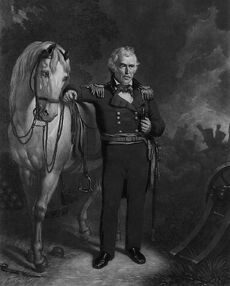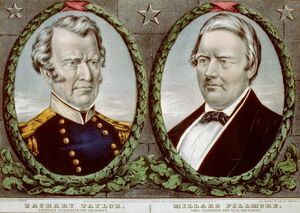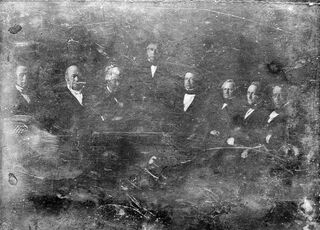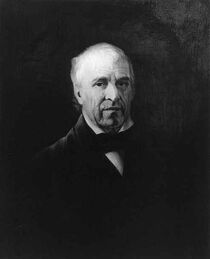| Zachary Taylor | |
 | |
| In office March 4, 1849[1] – July 9, 1850 | |
| Vice President | Millard Fillmore |
| Preceded by | James K. Polk |
| Succeeded by | Millard Fillmore |
| Born | November 24, 1784 Barboursville |
| Died | July 09, 1850 (age 65) Washington |
| Nationality | American |
| Political party | Whig |
| Spouse(s) | Margaret Smith Taylor |
| Occupation | Soldier (General) |
| Religion | Episcopal |
| Signature | |
Zachary Taylor (November 24, 1784 – July 9, 1850)[2] was an American military leader and the twelfth President of the United States. Known as "Old Rough and Ready," Taylor had a 40-year military career in the U.S. Army, serving in the War of 1812, Black Hawk War, and Second Seminole War after achieving fame while leading U.S. troops to victory at several critical battles of the Mexican-American War. A Southern slaveholder who opposed the spread of slavery to the territories, he was uninterested in politics but was recruited by the Whig Party as their nominee in the 1848 presidential election. In the election Taylor defeated the Democratic nominee, Lewis Cass, and became the first U.S. president never to hold any prior office. Taylor was also the first and to date only president from Louisiana, and the last southerner to be elected president until Woodrow Wilson (Andrew Johnson became president through succession).
As president, Taylor urged settlers in New Mexico and California to by-pass the territorial stage and draft constitutions for statehood, setting the stage for the Compromise of 1850.
Taylor died of acute gastroenteritis just 16 months into his term. Vice President Millard Fillmore became President.
Early life[]
Taylor was born on November 24, 1784, in a log cabin in Montecello, near Barboursville in Orange County.
Zachary Taylor was the third of nine of Richard Taylor and Sarah Strother. Taylor's family was aristocratic: James Madison was a second cousin and Robert E. Lee was a third cousin once removed (through Colonel Richard Lee the Immigrant). In his infancy, Taylor's family moved to Kentucky, where Taylor grew up on a plantation. He was known as "Little Zack" and was educated by private tutors. He was one of the descendants of King Edward I of England, as well as Mayflower passengers Isaac Allerton and William Brewster.
Taylor met Margaret "Peggy" Mackall Smith of Maryland in early 1810, and they were married on June 21, 1810. They had one son and five daughters, two of whom died in infancy because of malaria.
- Ann Mackall Taylor (born April 9, 1811)
- Sarah Knox "Knoxie" Taylor (born March 6, 1814-1835)
- Octavia Pannill Taylor (born 1816)
- Mary Smith Taylor (born 1819)
- Mary Elizabeth "Betty" Taylor (born April 20, 1824-1909)
- Richard "Dick" Taylor (born January 27, 1826-1879), Confederate States Army General
Sarah Knox Taylor married future Confederate president Jefferson Davis at age 21 over her father's strenuous objections; she died from malaria three months after the marriage.
Military career[]

General Zachary Taylor and his horse.
On May 3, 1808, Taylor joined the U.S. Army, receiving a commission as a first lieutenant of the Seventh Infantry Regiment. He was ordered west into Indiana Territory, taking command at the Battle of Fort Harrison; he was promoted to captain in November 1810.
During the War of 1812, Taylor became known as a talented military commander. Assigned to command Fort Harrison on the Wabash River, at the northern edge of present-day Terre Haute, Indiana, he successfully commandeered a small force of soldiers and civilians to stave off a British-inspired attack by about 500 Native Americans between September 4 and September 15. The Battle of Fort Harrison, as it became known, has been referred to as the "first American land victory of the War of 1812." Taylor received a brevet promotion to major on October 31, 1812. Taylor was promoted to lieutenant colonel on April 20, 1819, and colonel on April 5, 1832.
Taylor served in the Black Hawk War (May-August 1832) and the Second Seminole War (1835-1842). During the Seminole War, Taylor fought at the Battle of Lake Okeechobee and received a brevet promotion to brigadier general in January 1838. It was here he gained his nickname "Old Rough and Ready" for his rumpled clothes and wide-brimmed straw hat. On May 15, 1838, Taylor was promoted commanding general of all U.S. forces in Florida.
James K. Polk sent the Army of Occupation under Taylor's command to the Rio Grande in 1846. After Mexico sent a cavalry unit and attacked Taylor's troops (and additionally killed 16 American soldiers), Polk urged Congress to declare the Mexican-American War. In that conflict Taylor won additional important victories at Monterrey and Buena Vista and became a national hero.
Polk kept Taylor in Northern Mexico, disturbed by his informal habits of command and his affiliation with the Whig Party. He sent an expedition under General Winfield Scott to capture Mexico City. Taylor, incensed, thought that "the battle of Buena Vista opened the road to the city of Mexico and the halls of Montezuma, that others might revel in them."
Election of 1848[]

Taylor/Fillmore campaign poster
Taylor received the Whig nomination for President in 1848. Millard Fillmore of New York was chosen for the Vice Presidential nominee. Like many other army officers, Taylor was nonpolitical and had never voted. His homespun ways and his status as a war hero were political assets. Taylor defeated Lewis Cass, the Democratic candidate, and Martin Van Buren, the Free Soil candidate.
To the astonishment of Whigs, Taylor ignored their platform, as historian Michael Holt explains:
Taylor was equally indifferent to programs Whigs had long considered vital. Publicly, he was artfully ambiguous, refusing to answer queries about his views on banking, the tariff, and internal improvements. Privately, he was more forthright. The idea of a national bank "is dead, and will not be revived in my time." In the future the tariff "will be increased only for revenue"; in other words, Whig hopes of restoring the protective tariff of 1842 were vain. There would never again be surplus federal funds from public land sales to distribute to the states, and internal improvements "will go on in spite of presidential vetoes." In a few words, that is, Taylor pronounced an epitaph for the entire Whig economic program. [3]
Presidency[]
Policies[]

President Taylor and his Cabinet
From left to right: William B. Preston, Thomas Ewing, John M. Clayton, Zachary Taylor, William M. Meredith, George W. Crawford, Jacob Collamer and Reverdy Johnson, (1849).
Although Taylor had subscribed to Whig principles of legislative leadership, he was not inclined to be a puppet of Whig leaders in Congress. He ran his administration in the same rule-of-thumb fashion with which he had fought Indians.
Under Taylor's administration the United States Department of the Interior was organized, although the department had been activated under President Polk's last day in office. He appointed former Treasury Secretary Thomas Ewing the first Secretary of the Interior.
The Compromise of 1850[]
The slavery issue dominated Taylor's short term. Although he owned slaves, he took a moderate stance on the territorial expansion of slavery, angering fellow Southerners. Taylor urged settlers in New Mexico and California to draft constitutions and apply for statehood, bypassing the territorial stage. New Mexico was too small to act but California — which had high population growth from the gold rush — wrote a constitution that did not allow slavery; it was approved by the voters and a new state government took over in December 1849 without Congressional approval. Southerners were furious with Taylor and with California. In February 1850, Taylor held a stormy conference with Southern leaders who threatened secession. He told them that if necessary to enforce the laws, he personally would lead the Army. Persons "taken in rebellion against the Union, he would hang ... with less reluctance than he had hanged deserters and spies in Mexico." He never wavered. Henry Clay then proposed a complex Compromise of 1850. Taylor died as it was being debated. (The Clay version failed but another version did pass under the new president, Millard Fillmore.)
Administration and Cabinet[]

Portrait of Zachary Taylor
| The Taylor Cabinet | ||
|---|---|---|
| Office | Name | Term |
| President | Zachary Taylor | 1849–1850 |
| Vice President | Millard Fillmore | 1849–1850 |
| Secretary of State | John M. Clayton | 1849–1850 |
| Secretary of Treasury | William M. Meredith | 1849–1850 |
| Secretary of War | George W. Crawford | 1849–1850 |
| Attorney General | Reverdy Johnson | 1849–1850 |
| Postmaster General | Jacob Collamer | 1849–1850 |
| Secretary of the Navy | William B. Preston | 1849–1850 |
| Secretary of the Interior | Thomas Ewing, Sr. | 1849–1850 |
Supreme Court appointments[]
none
States admitted to the Union[]
none
Death[]

General Zachary Taylor in uniform.
The cause of Zachary Taylor's death is not well understood, nor is it well documented. On July 4, 1850, Taylor was diagnosed by his physicians with cholera morbus, a term that included diarrhea and dysentery but not true cholera. Cholera, typhoid fever, and food poisoning have all been indicated as the source of the president's ultimately fatal gastroenteritis. More specifically, a hasty snack of iced milk, cold cherries and pickled cucumbers consumed at an Independence Day celebration might have been the culprit.[4] By July 9, Taylor was dead.
In 1991, with permission from his descendants, Taylor's body was exhumed, and Larry Robinson and Frank Dyer conducted an autopsy at the Oak Ridge National Laboratory. At the exhumation, observers noted that Taylor's body, while somewhat decomposed, was still instantly recognizable as the 12th President — Taylor's brow ridge remained intact. Investigating the possibility of assassination by means of deliberate poisoning, Dyer and Robinson detected traces of arsenic and sent the results to a Kentucky medical examiner, who determined the quantity of arsenic present — there is a faint amount of arsenic present naturally in the human body — was several hundred times less than there would have been had he been poisoned with arsenic.[5] Despite these findings, assassination theories have not been entirely put to rest. Michael Parenti devoted a chapter in his controversial 1999 book History as Mystery to what he called "The Strange Death of Zachary Taylor". In it he speculates that Taylor was assassinated and that his autopsy was botched.

Taylor postage stamp
There is some strong evidence that Taylor died from complications of heat stroke. On July 4, 1850, the weather in Washington was hot and rather humid. Taylor was there to preside over ceremonies at the laying of the cornerstone of the Washington Monument. Taylor was sporting a thick coat, vest, high-collared shirt, and a top hat. Shortly after arriving, Taylor complained that he was very thirsty. He went to the reception table and downed a large amount of water directly from a pitcher.
Since the water was sitting in the sun, the idea of cholera is a possibility. But Taylor exhibited classic symptoms of heat stroke, particularly red, flushed skin on the face. Records also indicate that Taylor was having trouble walking and exhibiting slurred speech. At no time while outside did anyone loosen or remove Taylor's clothing. Only after returning to the White House was some of his clothing loosened. It was only a short time before Taylor collapsed.
At this point his clothing was removed, but internal organs had already been damaged. In fact, his doctors were mystified as to the cause of multiple organ failure. Medical sciences had not addressed heat stroke and the internal damage caused by it. According to author Charles Panati, Taylor actually awoke briefly and said: "I should not be surprised if this were to result in my death." He took a few sips of iced milk, again adding to the possibility of cholera. He lapsed again into unconsciousness and died on July 9, 1850.
Taylor is buried in Louisville, at what is now the Zachary Taylor National Cemetery.
Surviving family[]
- Taylor's son Richard became a Confederate Lieutenant General, while his daughter Sarah Knox Taylor (1814–1835) had married future President of the Confederate States Jefferson Davis three months before her death of malaria.
- Taylor's brother, Joseph Pannill Taylor, was a Brigadier General in the Union Army during the Civil War. (Joseph P. Taylor's son Joseph Hancock Taylor was a US Colonel in the Civil War and was also a son-in-law of Union General Montgomery C. Meigs).
- Taylor's niece Emily Ellison Taylor was the wife of Confederate General Lafayette McLaws.
- Ann Taylor's son John Taylor Wood, a U.S. Navy officer defected to the Confederate side and later fled to Canada during the Civil War; his great-grandson Zachary Taylor Wood was Acting RCMP Commssioner, great-great-grandson Stuart Taylor Wood was Commissioner of the Royal Canadian Mounted Police and great-great-great-grandsons (Cst. Herschel Wood and Supt.(Ret) John Taylor Wood served in the RCMP.
References[]
- ^ *Taylor's term of service was scheduled to begin on March 4, 1849, but as this day fell on a Sunday, Taylor refused to be sworn in until the following day. Vice President Millard Fillmore was also not sworn in on that day. Most scholars believe that according to the {{subst:#ifexist:United States Constitution|U.S. Constitution|U.S. Constitution}}, Taylor's term began on March 4, regardless of whether he had taken the oath or not.
- ^ Taylor was the first President to have been born after the end of the Revolutionary War and the Treaty of Paris. This makes him the first President born to the undisputed, self-governed American Colonies.
- ^ Holt 1999 p 272
- ^ Historynet.com Magazine Publisher: Picture of the Day
- ^ "President Zachary Taylor and the Laboratory: Presidential Visit from the Grave" from {{subst:#ifexist:Oak Ridge National Laboratory|[[Oak Ridge National Laboratory|]]|[[Wikipedia:Oak Ridge National Laboratory|]]}}
Further reading[]
- Bauer, Jack K. Zachary Taylor: Soldier, Planter, Statesman of the Old Southwest. Louisiana State University Press: 1993. ISBN 0-8071-1851-6
- Hamilton, Holman. Zachary Taylor: Soldier of the Republic (1941) vol 1
- Hamilton, Holman. Zachary Taylor: Soldier in the White House (1951) vol 2
- Michael F. Holt; The Rise and Fall of the American Whig Party: Jacksonian Politics and the Onset of the Civil War. (1999)
- Smith, Elbert B. The Presidencies of Zachary Taylor and Millard Fillmore. University Press of Kansas: 1988. ISBN 0-7006-0362-X.
- List of United States Presidents who died in office
External links[]
- Extensive essay on Zachary Taylor and shorter essays on each member of his cabinet and First Lady from the Miller Center of Public Affairs
- White House Biography
- Biography by Appleton's and Stanley L. Klos
- Zachary Taylor State of the Union Address
- Zachary Taylor letters from 1846-1848
- Medical and Health history of Zachary Taylor
- Photo of grave of President Zachary Taylor, with GPS coordinates
- General Taylor's letters : letter of Gen. Taylor to Gen Gaines; Secretary Marcy's reprimand of Gen. Taylor; and Gen. Taylor's reply; with the fable alluded to annexed
- Genealogy of Zachary Taylor
| Political offices | ||
|---|---|---|
| Preceded by James K. Polk |
President of the United States March 4, 1849 – July 9, 1850 |
Succeeded by Millard Fillmore |
| Party political offices | ||
| Preceded by Henry Clay |
Whig Party presidential nominee 1848 |
Succeeded by Winfield Scott |
| ||||||||||||||
| |||||
| Persondata | |
|---|---|
| NAME | Taylor, Zachary |
| ALTERNATIVE NAMES | |
| SHORT DESCRIPTION | President of the USA, 1849-50 |
| DATE OF BIRTH | November 24 1784 |
| PLACE OF BIRTH | Barboursville |
| DATE OF DEATH | July 9 1850 |
| PLACE OF DEATH | Washington |
| This page uses content from the English language Wikipedia. The original content was at Zachary Taylor. The list of authors can be seen in the page history. As with this Familypedia wiki, the content of Wikipedia is available under the Creative Commons License. |



